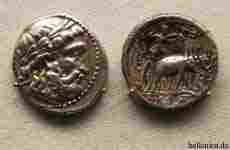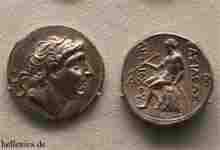.
Seleucia on the Tigris (Greek: Σέλεύχεια) – in the Talmud, Selik, Selika, and Selikos; in the Aramaic Targum, Salwaḳia or Salwaḳya; also formerly Zochasia, Coche, Mahoza, and Veh Ardashir – formerly the site a city named Zochasia was enlarged and dedicated as the first capital city of the Seleucid Empire by Seleucus I Nicator circa 305 BC. [1] It stood on the west bank of the Tigris River opposite the smaller town of Opis (later Ctesiphon). It did not remain his main capital for long, as he soon transferred it from there to Antioch on the Orontes in northern Syria.
Lying at the confluence of the Tigris River and a major canal from the Euphrates, Seleucia was in a position to receive traffic from both great waterways. During the third and second centuries BC, it was one of the great Hellenistic capitals comparable to Alexandria in Egypt and greater than Syrian Antioch.
In 141 BC, the Parthians under Mithridates conquered the city, and Seleucia became the western capital of the Parthian Empire. Tacitus described its walls, and mentioned that it was (even under Parthian rule) a fully Hellenistic city. Ancient texts say that the city had 600,000 people, and was ruled by a senate of 300 people. It was one of the largest cities in the world, and only Rome and Alexandria were more populous. The city was the scene of a massacre of around 5,000 Babylonian Jewish refugees, circa 41 BC (Josephus, Ant. xviii. 9, § 9). [2]
Seleucia was burned down by Trajan in 117 AD, relinquished by Hadrian the following year, then rebuilt in the Parthian style. It was finally destroyed by the Roman Empire in 164 AD. Ardashir I of Persia rebuilt the city, renaming it Veh-Ardashir. It is now under a suburb about 18 miles south of modern Baghdad.
Archaeology
Beginning in 1927, University of Michigan professors Leroy Waterman (1927-1932) and Clark Hopkins (1936-1937) oversaw excavations for the Kelsey Museum of Archaeology on behalf of the American School of Oriental Research of Baghdad with funds supplied by the Toledo Museum of Art and the Cleveland Museum of Art. From 1964 till 1989 an Italian mission from the University of Turin excavated at the site. They found a Seleucid archive building with about 15 000 seal impressions, all in a fully Greek style.
In an outer wall of the Parthian period, a reused brick dated by stamp to 821 BC, during the Neo-Babylonian period.
It appears to have incorporated both Greek and Mesopotamian architecture for the public buildings. Finds have indicated an extensive non-Greek population.
References
Richard Talbert, Barrington Atlas of the Greek and Roman World, (ISBN 069103169X), p. 91.
Links
- Seleucia on the Tigris, Iraq
- Hazlitt's Classical Gazetteer "Seleucia"
- Jewish Encyclopedia "Seleucia"
| Ancient Greece
Science, Technology , Medicine , Warfare, , Biographies , Life , Cities/Places/Maps , Arts , Literature , Philosophy ,Olympics, Mythology , History , Images Medieval Greece / Byzantine Empire Science, Technology, Arts, , Warfare , Literature, Biographies, Icons, History Modern Greece Cities, Islands, Regions, Fauna/Flora ,Biographies , History , Warfare, Science/Technology, Literature, Music , Arts , Film/Actors , Sport , Fashion --- |
Retrieved from "http://en.wikipedia.org/"
All text is available under the terms of the GNU Free Documentation License




